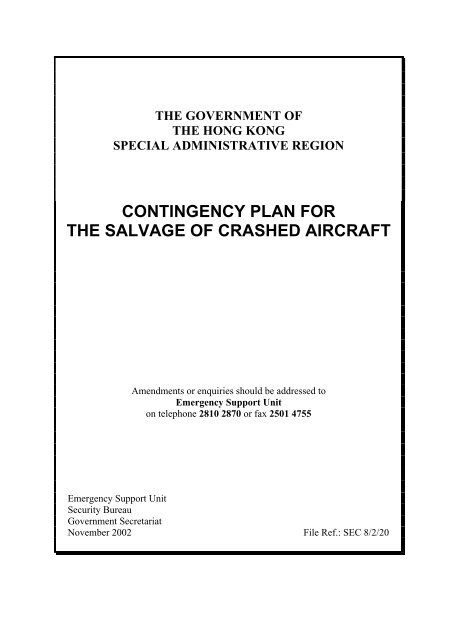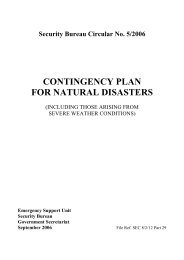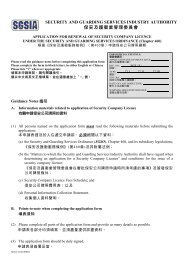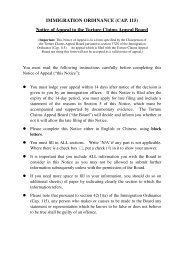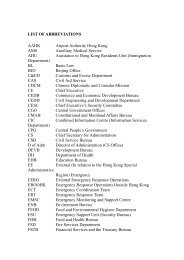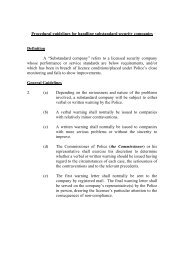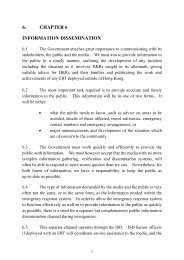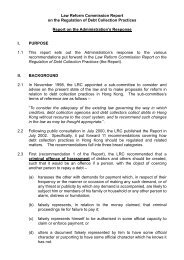CONTINGENCY PLAN FOR THE SALVAGE OF CRASHED AIRCRAFT
CONTINGENCY PLAN FOR THE SALVAGE OF CRASHED AIRCRAFT
CONTINGENCY PLAN FOR THE SALVAGE OF CRASHED AIRCRAFT
You also want an ePaper? Increase the reach of your titles
YUMPU automatically turns print PDFs into web optimized ePapers that Google loves.
Contingency Plan for the Salvage of Crashed Aircraft 1 of 10 This contingency plan summarisesthe functions and responsibilities of Government departments and other bodieswhich may be involved in the salvage of a crashed aircraft.Separate contingency plans entitledContingency Plan for Maritime and Aeronautical Search & RescueandContingency Plan for Dealing with an Aircraft Crash in Hong Konghave been issued.This contingency plan is supplementary to and should be readin conjunction with the above-mentioned contingency plans.Each department has its own more detailed departmental plans/instructions.
Contingency Plan for the Salvage of Crashed Aircraft 3 of 10IINTRODUCTIONDefinitionFor the purpose of this Contingency Plan, salvage includes recovery of acrashed aircraft and/or things inside the wreckage, be they on land or at sea.Alerting System2. Those Departments and other organisations which may be involved insalvage operations will normally have already been involved at the crash, searchand rescue stages. There are separate contingency plans entitled ‘ContingencyPlan for Maritime and Aeronautical Search and Rescue’ and ‘Contingency Plan forDealing with an Aircraft Crash in Hong Kong’, which give full details of thealerting procedures for these emergencies.Purpose of Salvage Operations3. The primary purpose of most salvage operations is to enable the cause of anaircraft accident to be determined. For this reason, the preservation of wreckage,in situ, if possible, is of considerable importance. A crashed aircraft should notbe disturbed without the approval of the Controlling Authority (see paragraph 4below) except insofar as is necessary for:-a) extricating persons or animals from it;b) removing mail from it;c) preventing it from being destroyed or further damaged by fire or othercauses;d) preventing any damage or obstruction to the public, to air traffic, or toother transport;e) removing property from it under the supervision of a police officer;andf) in the case of an aircraft wrecked on the water, removing it and itscontents to a place of safety.Even in these circumstances, a photographic record of the wreckage and anyground marks should be obtained prior to disturbance, if at all possible. In thecase of wreckage in water, the position should be marked by buoys.
Contingency Plan for the Salvage of Crashed Aircraft 4 of 10IICONTROLLING AUTHORITY4. The Controlling Authority is responsible for initiating and co-ordinatingsalvage operations. The Controlling Authority will vary according to aircraftownership and the type and location of the accident as elaborated in the ensuingparagraphs.5. The Controlling Authority will set up an Aircraft Recovery Committeewhich will comprise of representatives of Government Departments andorganisations concerned for the purposes of mapping out and deciding the courseof action ahead.Civil Aircraft6. The Chief Executive Officer of the Airport Authority Hong Kong (AAHK)in consultation with the Director-General of Civil Aviation (DG of CA) shall beresponsible for initiating and co-ordinating salvage operations when:-a) a civil aircraft crash in the Airport Area (within the meaning of theAirport Authority Ordinance) of the international airport at Chek LapKok which is subject to investigation; orb) an aircraft wreckage constitutes an unacceptable obstruction to theoperation of the international airport.7. The DG of CA will normally be the Controlling Authority for civil aircraftcrash in water and on land off the Airport Area if the incident becomes the subjectof investigation under the Hong Kong Civil Aviation (Investigation of Accidents)Regulations.Government Flying Service (GFS) Aircraft8. GFS aircraft are on the Civil Aircraft Register. Therefore, any accidentsrelated to GFS aircraft are subject to investigation by DG of CA under the HongKong Civil Aviation (Investigation of Accidents) Regulations.
Contingency Plan for the Salvage of Crashed Aircraft 5 of 10Summary9. In brief, the Controlling Authorities of various kinds of aircraft accidentsare as follows-Type of AccidentControlling Authority1. Civil aircraft crash in the internationalairport which is subject toinvestigation or any aircraft wreckagewhich constitutes an unacceptableobstruction to the operation of theairportAAHK in consultation with Director-General of Civil Aviation2. Civil aircraft accident on land off theinternational airport and which issubject to investigationDirector-General of Civil Aviation3. Civil aircraft accident on water andwhich is subject to investigationDirector-General of Civil Aviation4. Aircraft accident not subject toinvestigationAircraft Owner/Operator10. Until formal advice to the contrary is received, organisations involved in anaircraft accident shall assume that the accident is subject to investigation and shallact accordingly.
Contingency Plan for the Salvage of Crashed Aircraft 6 of 10IIINON-GOVERNMENT ORGANISATIONS’ RESPONSIBILITIESAirport Authority Hong Kong (AAHK)11. When acting as the Controlling Authority, AAHK will be responsible forco-ordinating salvage operations with Civil Aviation Department, Police, AirportFire Contingent, the airline company of the crashed aircraft, maintenance andfuelling franchisees. After ensuring that the position of wreckage is properlysurveyed and recorded for the purpose of accident investigation, AAHK will causeexpeditious removal of the crashed aircraft from the aircraft movement areas andits subsequent disposal. It will provide aircraft recovery equipment; accesscontrol at the accident scene in conjunction with Police; escort of personnel andvehicles involved in the aircraft salvage; and a physical barrier to fence off thewreckage. In the event of a spill of dangerous goods or other chemical on theairport platform during salvage operation, the disposal of chemical waste andsubsequent area clean up will follow the procedures prescribed in the EmergencyProcedures Manual of the Airport Authority.Aircraft Owner/Operator12. The owner/operator of the crashed aircraft shall be responsible for theunloading of baggage and freight; the removal of the disabled aircraft; its storageand subsequent disposal under the direction of the Controlling Authority. Theowner/operator shall be the ultimate body to bear all salvage costs, and providesuch technical advice and information to the Controlling Authority as is necessary.The owner/operator, when acting as the Controlling Authority, will be responsiblefor co-ordinating salvage operations.Into-plane Fuelling Franchisees13. The Airport Authority Into-Plane Fuelling Franchisees companies based atthe airport will be responsible for defuelling of the aircraft and the analysis of fuelcontent as and when required by the accident investigator.Aircraft Maintenance Franchisees14. The Airport Authority Aircraft Maintenance Franchisees can be called on toassist in aircraft salvage and disposal.
Contingency Plan for the Salvage of Crashed Aircraft 7 of 10IVBUREAUX’S AND DEPARTMENTS’ RESPONSIBILITIESCivil Aviation Department (CAD)15. When acting as the Controlling Authority, the Director-General of CivilAviation will co-ordinate salvage operations after ensuring that the position ofwreckage is properly surveyed and recorded for the purpose of accidentinvestigation, and preserve with assistance from the Police the aircraft wreckageand any other evidence for subsequent investigation.Civil Engineering and Development Department (CEDD)16. The Technical Services Division of the Civil Engineering Office will beresponsible for providing divers and floating equipment to assist in salvageoperations in the event of an aircraft crashing into the sea.Department of Health (DH)17. The Director of Health will be responsible for the provision of a physicist togive guidance on the removal of radioactive material from a crashed aircraft. Acopy of the current month’s Radiation Accidents Duty Roster of Physicists is filedin the Department of Health folder kept in the Emergency Monitoring and SupportCentre. In the event of an accidental spillage/leakage of transhipment infectioussubstances during salvage operation, depending on where this occurs, staff of thePort Health Office (if the event occurs within or in the immediate vicinity of theairport) or the Headquarters Duty Officer (if the event occurs elsewhere in HongKong) may be called upon to give advice on containment, decontamination,disposal and the subsequent environmental cleanup.Electrical and Mechanical Services Department (EMSD)18. The Director of Electrical and Mechanical Services will be responsible forproviding heavy salvage equipment from his departmental resources.Environmental Protection Department (EPD)19. The Director of Environmental Protection will be responsible for givingadvice to other Government Departments like the Fire Services Department, theGovernment Laboratory and the Marine Department, to prevent the crash vicinityfrom contamination by the spilt fuel or other chemicals during the salvage
Contingency Plan for the Salvage of Crashed Aircraft 8 of 10operation. For chemical waste arising from handling the spilt fuel or otherchemicals during the salvage operation in public venues or places, the Director ofEnvironmental Protection will be responsible for collecting and transportingchemical waste that can be treated at the Chemical Waste Treatment Centre. TheControlling Authority or Government Department responsible for management ofthe affected area will provide assistance to EPD such as plant, equipment andmanpower in cleaning up the area.Fire Services Department (FSD)20. The Director of Fire Services will be responsible for fire protection duringsalvage operations, provision of specialized equipment and sluicing downwreckage recovered from the sea as directed by the Accident Investigatornominated by the Controlling Authority. FSD divers may be called upon to assistthe Controlling Authority or the Police in the salvage and preservation of evidenceunder the direction of the Salvage Officer nominated by the Controlling Authority.FSD will also be responsible for recovering any radioactive materials under theguidance of a physicist of the Department of Health.Government Flying Service (GFS)21. GFS should assist in accident investigation as required by the Director-General of Civil Aviation in providing aerial surveys of the accident site and airliftof Inspectors of Accidents.Hong Kong Police Force (HKPF)22. The Commissioner of Police will be responsible for securing the area of thecrash and preventing disturbance of it, the aircraft or its contents except for thepurposes as described in paragraph 3 above. Preservation of the scene of thecrash as well as the wreckage will be enforced by the Police until a physicalbarrier is erected to fence off the wreckage or other arrangements are made byCAD. In the event of a protracted or large scale incident and at the request of theControlling Authority, the Police may be able to provide divers to assist withsalvage operations. If there are reasons to suspect the crash has been caused by acriminal act, the Police divers should be called upon for the recovery andpreservation of evidence. The Police will also provide an official photographer.
Contingency Plan for the Salvage of Crashed Aircraft 9 of 10Lands Department (Lands D)23. The Survey and Mapping Office will be responsible for providingassistance in fixing the position of the wreckage or other physical evidence bysurvey, and for obtaining aerial and/or terrestrial photographs of the crash site.Marine Department (MD)24. If salvage of a crashed aircraft is carried out at sea, the Director of Marinewill provide professional input to the Controlling Authority and assist wherenecessary in salvage operations. He will send a liaison officer to the AircraftRecovery Committee. If heavy lift crane barges are needed, Marine Departmentmay hire crane barges from private organisations. Funds for such service will bepaid by the Controlling Authority. The Department will liaise with contractor ofthe crane barge for execution of the salvage plan as decided by the AircraftRecovery Committee. The Department will control and regulate marine traffic inthe vicinity of the salvage site, and provide escort service during transportation ofthe crashed aircraft. If under water survey is required to locate position of theaircraft, the Department will dispatch its hydrographic surveying team for thispurpose.VEMERGENCY RESOURCES AVAILABILITY25. Apart from the emergency resources provided by the front-line emergencyDepartments, i.e. FSD and the Police, there are other emergency resources liketrucks, lorries, heavy-duty lifting equipment, cutting sets, flood lights, recoveryvehicles and launches, etc. available from the Works Departments and theircontractors. A list showing the details of these emergency resources prepared bythe Environment, Transport and Works Bureau will be circulated to CAD, FSD,the Police, Security Bureau and all Works Departments annually for reference. Ifresources from private organisations are hired or acquired, the ControllingAuthority is responsible for defraying necessary expenses.VIREVISION <strong>OF</strong> <strong>THE</strong> <strong>PLAN</strong>26. Security Bureau will co-ordinate regular review of the Contingency Plan inconsultation with all relevant parties. The Contingency Plan may alsoincorporate recommendations made as a result of exercises for improvements intraining, equipment and procedures and so on.
Contingency Plan for the Salvage of Crashed Aircraft 10 of 1027. All Bureaux, Departments and other organisations are responsible forpromptly notifying Security Bureau, as and when they occur, of any changes tothis plan that may be necessary as a result of reorganisations, changes incapabilities and available resources, changes in telephone and facsimile numbersand so on.VIITELEPHONE AND O<strong>THE</strong>R COMMUNICATIONS DIRECTORY28. For telephone numbers required for this plan, please refer to the HONGKONG EMERGENCY TELEPHONE DIRECTORY.Emergency Support UnitSecurity BureauGovernment SecretariatNovember 2002


